Business Law Assignment: Contract Law Analysis, TLAW 401, 2020
VerifiedAdded on 2022/08/24
|11
|3123
|14
Homework Assignment
AI Summary
This assignment solution addresses a business law case involving a contract dispute between Rita and her uncle, Mr. Chorwala. The core issue revolves around the absence of a signed contract for a lease agreement and whether a valid contract existed despite the lack of a formal written document. The solution analyzes the essential elements of a contract, including offer, acceptance, consideration, capacity, and intention to create legal relations, applying relevant legal principles and case law. It examines the facts, identifies the legal issues, and applies the rules of contract law, including promissory estoppel, to determine the rights and liabilities of each party. The analysis considers whether Rita can enforce the agreement and seek remedies for her incurred expenses, concluding with a discussion on the potential outcomes based on the application of contract law principles.

Business Law
1/21/2020
Student’s Name
1/21/2020
Student’s Name
Paraphrase This Document
Need a fresh take? Get an instant paraphrase of this document with our AI Paraphraser
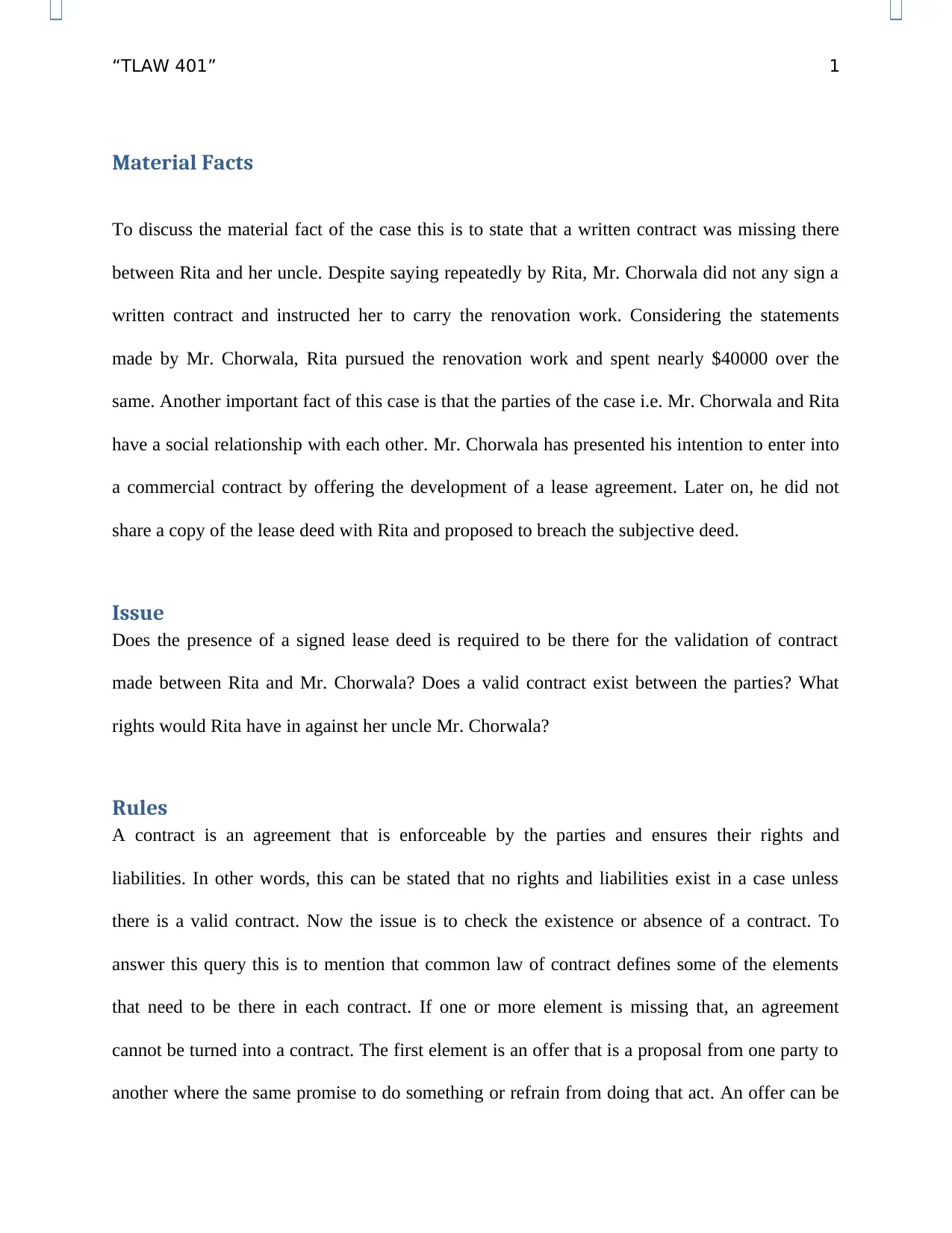
“TLAW 401” 1
Material Facts
To discuss the material fact of the case this is to state that a written contract was missing there
between Rita and her uncle. Despite saying repeatedly by Rita, Mr. Chorwala did not any sign a
written contract and instructed her to carry the renovation work. Considering the statements
made by Mr. Chorwala, Rita pursued the renovation work and spent nearly $40000 over the
same. Another important fact of this case is that the parties of the case i.e. Mr. Chorwala and Rita
have a social relationship with each other. Mr. Chorwala has presented his intention to enter into
a commercial contract by offering the development of a lease agreement. Later on, he did not
share a copy of the lease deed with Rita and proposed to breach the subjective deed.
Issue
Does the presence of a signed lease deed is required to be there for the validation of contract
made between Rita and Mr. Chorwala? Does a valid contract exist between the parties? What
rights would Rita have in against her uncle Mr. Chorwala?
Rules
A contract is an agreement that is enforceable by the parties and ensures their rights and
liabilities. In other words, this can be stated that no rights and liabilities exist in a case unless
there is a valid contract. Now the issue is to check the existence or absence of a contract. To
answer this query this is to mention that common law of contract defines some of the elements
that need to be there in each contract. If one or more element is missing that, an agreement
cannot be turned into a contract. The first element is an offer that is a proposal from one party to
another where the same promise to do something or refrain from doing that act. An offer can be
Material Facts
To discuss the material fact of the case this is to state that a written contract was missing there
between Rita and her uncle. Despite saying repeatedly by Rita, Mr. Chorwala did not any sign a
written contract and instructed her to carry the renovation work. Considering the statements
made by Mr. Chorwala, Rita pursued the renovation work and spent nearly $40000 over the
same. Another important fact of this case is that the parties of the case i.e. Mr. Chorwala and Rita
have a social relationship with each other. Mr. Chorwala has presented his intention to enter into
a commercial contract by offering the development of a lease agreement. Later on, he did not
share a copy of the lease deed with Rita and proposed to breach the subjective deed.
Issue
Does the presence of a signed lease deed is required to be there for the validation of contract
made between Rita and Mr. Chorwala? Does a valid contract exist between the parties? What
rights would Rita have in against her uncle Mr. Chorwala?
Rules
A contract is an agreement that is enforceable by the parties and ensures their rights and
liabilities. In other words, this can be stated that no rights and liabilities exist in a case unless
there is a valid contract. Now the issue is to check the existence or absence of a contract. To
answer this query this is to mention that common law of contract defines some of the elements
that need to be there in each contract. If one or more element is missing that, an agreement
cannot be turned into a contract. The first element is an offer that is a proposal from one party to
another where the same promise to do something or refrain from doing that act. An offer can be
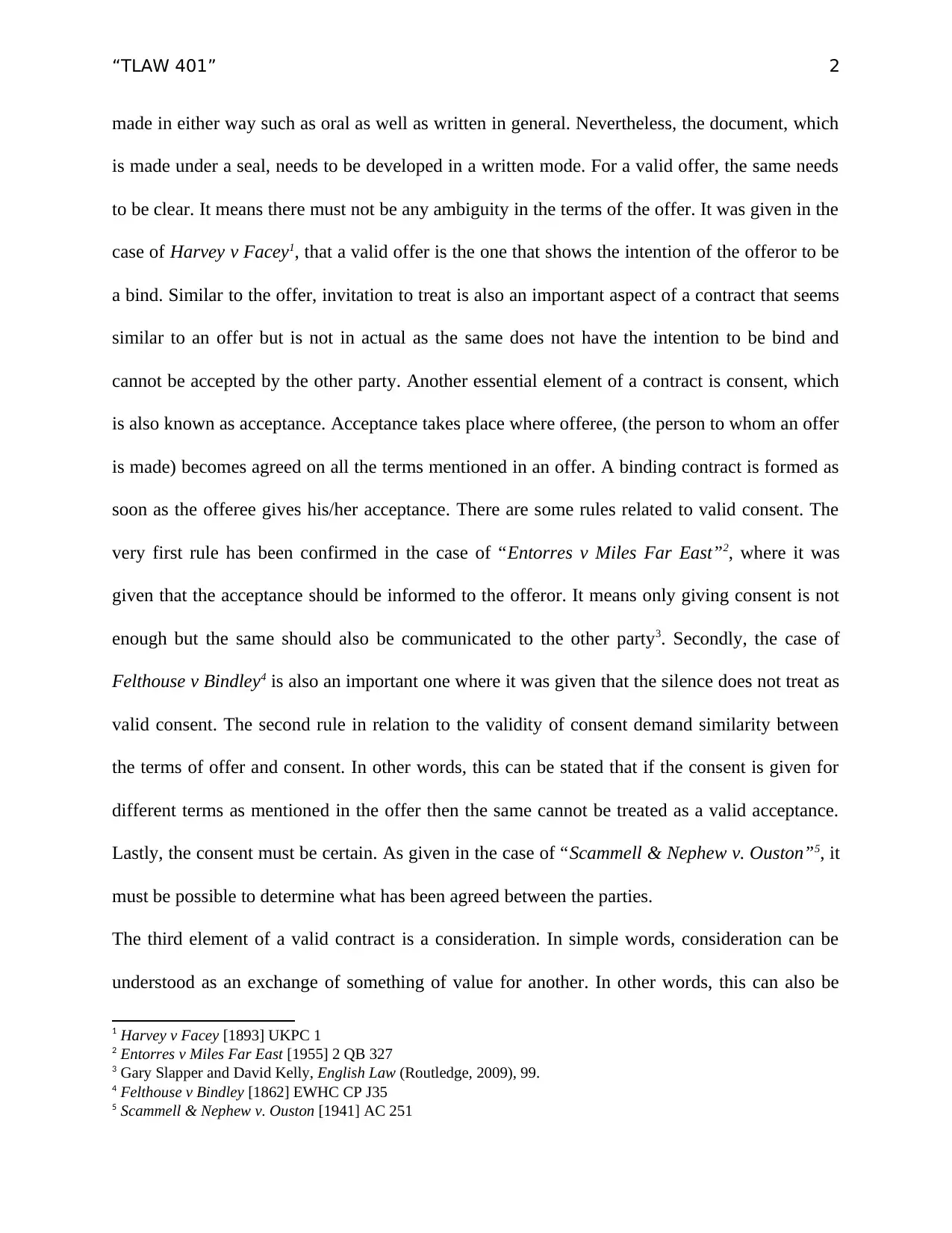
“TLAW 401” 2
made in either way such as oral as well as written in general. Nevertheless, the document, which
is made under a seal, needs to be developed in a written mode. For a valid offer, the same needs
to be clear. It means there must not be any ambiguity in the terms of the offer. It was given in the
case of Harvey v Facey1, that a valid offer is the one that shows the intention of the offeror to be
a bind. Similar to the offer, invitation to treat is also an important aspect of a contract that seems
similar to an offer but is not in actual as the same does not have the intention to be bind and
cannot be accepted by the other party. Another essential element of a contract is consent, which
is also known as acceptance. Acceptance takes place where offeree, (the person to whom an offer
is made) becomes agreed on all the terms mentioned in an offer. A binding contract is formed as
soon as the offeree gives his/her acceptance. There are some rules related to valid consent. The
very first rule has been confirmed in the case of “Entorres v Miles Far East”2, where it was
given that the acceptance should be informed to the offeror. It means only giving consent is not
enough but the same should also be communicated to the other party3. Secondly, the case of
Felthouse v Bindley4 is also an important one where it was given that the silence does not treat as
valid consent. The second rule in relation to the validity of consent demand similarity between
the terms of offer and consent. In other words, this can be stated that if the consent is given for
different terms as mentioned in the offer then the same cannot be treated as a valid acceptance.
Lastly, the consent must be certain. As given in the case of “Scammell & Nephew v. Ouston”5, it
must be possible to determine what has been agreed between the parties.
The third element of a valid contract is a consideration. In simple words, consideration can be
understood as an exchange of something of value for another. In other words, this can also be
1 Harvey v Facey [1893] UKPC 1
2 Entorres v Miles Far East [1955] 2 QB 327
3 Gary Slapper and David Kelly, English Law (Routledge, 2009), 99.
4 Felthouse v Bindley [1862] EWHC CP J35
5 Scammell & Nephew v. Ouston [1941] AC 251
made in either way such as oral as well as written in general. Nevertheless, the document, which
is made under a seal, needs to be developed in a written mode. For a valid offer, the same needs
to be clear. It means there must not be any ambiguity in the terms of the offer. It was given in the
case of Harvey v Facey1, that a valid offer is the one that shows the intention of the offeror to be
a bind. Similar to the offer, invitation to treat is also an important aspect of a contract that seems
similar to an offer but is not in actual as the same does not have the intention to be bind and
cannot be accepted by the other party. Another essential element of a contract is consent, which
is also known as acceptance. Acceptance takes place where offeree, (the person to whom an offer
is made) becomes agreed on all the terms mentioned in an offer. A binding contract is formed as
soon as the offeree gives his/her acceptance. There are some rules related to valid consent. The
very first rule has been confirmed in the case of “Entorres v Miles Far East”2, where it was
given that the acceptance should be informed to the offeror. It means only giving consent is not
enough but the same should also be communicated to the other party3. Secondly, the case of
Felthouse v Bindley4 is also an important one where it was given that the silence does not treat as
valid consent. The second rule in relation to the validity of consent demand similarity between
the terms of offer and consent. In other words, this can be stated that if the consent is given for
different terms as mentioned in the offer then the same cannot be treated as a valid acceptance.
Lastly, the consent must be certain. As given in the case of “Scammell & Nephew v. Ouston”5, it
must be possible to determine what has been agreed between the parties.
The third element of a valid contract is a consideration. In simple words, consideration can be
understood as an exchange of something of value for another. In other words, this can also be
1 Harvey v Facey [1893] UKPC 1
2 Entorres v Miles Far East [1955] 2 QB 327
3 Gary Slapper and David Kelly, English Law (Routledge, 2009), 99.
4 Felthouse v Bindley [1862] EWHC CP J35
5 Scammell & Nephew v. Ouston [1941] AC 251
⊘ This is a preview!⊘
Do you want full access?
Subscribe today to unlock all pages.

Trusted by 1+ million students worldwide
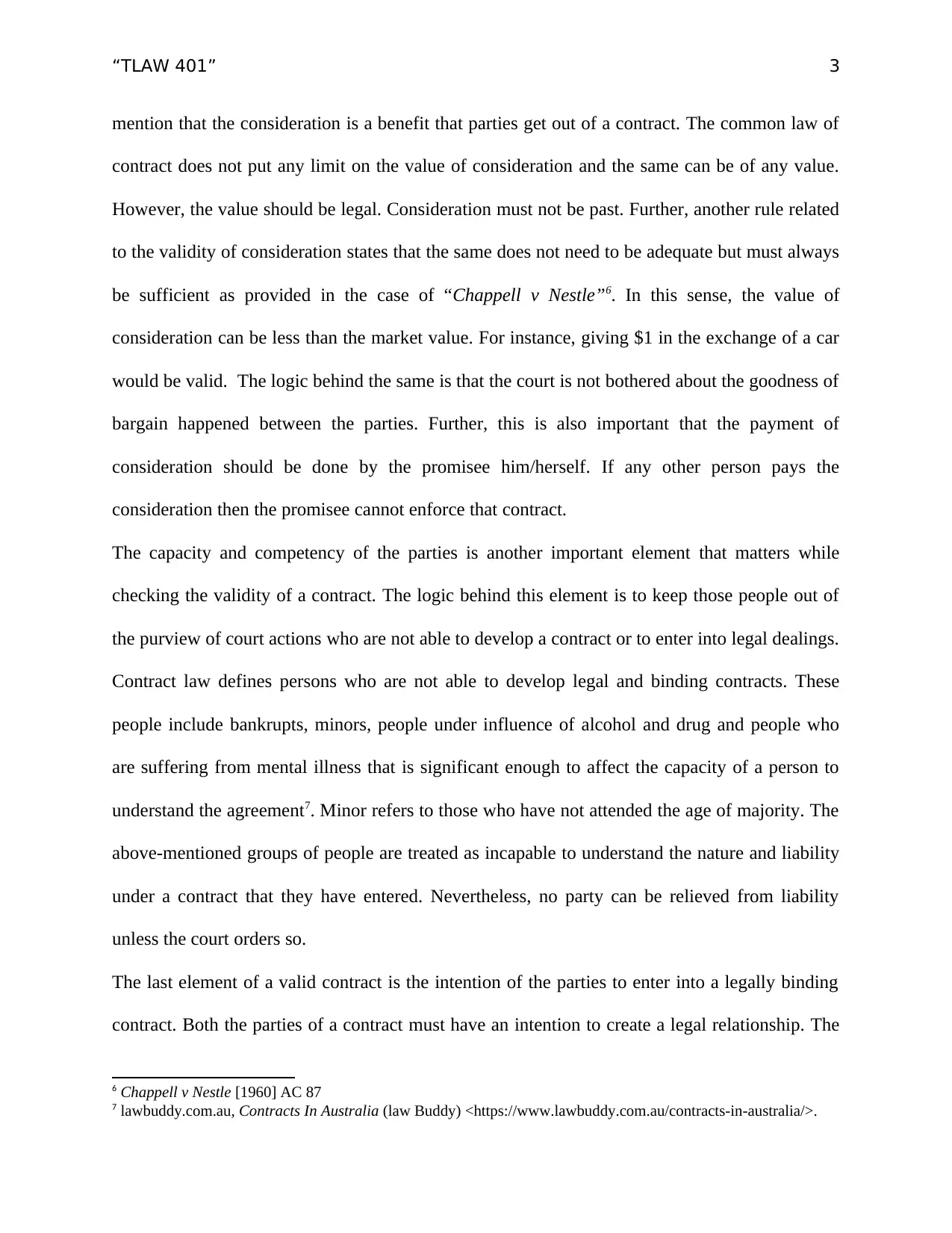
“TLAW 401” 3
mention that the consideration is a benefit that parties get out of a contract. The common law of
contract does not put any limit on the value of consideration and the same can be of any value.
However, the value should be legal. Consideration must not be past. Further, another rule related
to the validity of consideration states that the same does not need to be adequate but must always
be sufficient as provided in the case of “Chappell v Nestle”6. In this sense, the value of
consideration can be less than the market value. For instance, giving $1 in the exchange of a car
would be valid. The logic behind the same is that the court is not bothered about the goodness of
bargain happened between the parties. Further, this is also important that the payment of
consideration should be done by the promisee him/herself. If any other person pays the
consideration then the promisee cannot enforce that contract.
The capacity and competency of the parties is another important element that matters while
checking the validity of a contract. The logic behind this element is to keep those people out of
the purview of court actions who are not able to develop a contract or to enter into legal dealings.
Contract law defines persons who are not able to develop legal and binding contracts. These
people include bankrupts, minors, people under influence of alcohol and drug and people who
are suffering from mental illness that is significant enough to affect the capacity of a person to
understand the agreement7. Minor refers to those who have not attended the age of majority. The
above-mentioned groups of people are treated as incapable to understand the nature and liability
under a contract that they have entered. Nevertheless, no party can be relieved from liability
unless the court orders so.
The last element of a valid contract is the intention of the parties to enter into a legally binding
contract. Both the parties of a contract must have an intention to create a legal relationship. The
6 Chappell v Nestle [1960] AC 87
7 lawbuddy.com.au, Contracts In Australia (law Buddy) <https://www.lawbuddy.com.au/contracts-in-australia/>.
mention that the consideration is a benefit that parties get out of a contract. The common law of
contract does not put any limit on the value of consideration and the same can be of any value.
However, the value should be legal. Consideration must not be past. Further, another rule related
to the validity of consideration states that the same does not need to be adequate but must always
be sufficient as provided in the case of “Chappell v Nestle”6. In this sense, the value of
consideration can be less than the market value. For instance, giving $1 in the exchange of a car
would be valid. The logic behind the same is that the court is not bothered about the goodness of
bargain happened between the parties. Further, this is also important that the payment of
consideration should be done by the promisee him/herself. If any other person pays the
consideration then the promisee cannot enforce that contract.
The capacity and competency of the parties is another important element that matters while
checking the validity of a contract. The logic behind this element is to keep those people out of
the purview of court actions who are not able to develop a contract or to enter into legal dealings.
Contract law defines persons who are not able to develop legal and binding contracts. These
people include bankrupts, minors, people under influence of alcohol and drug and people who
are suffering from mental illness that is significant enough to affect the capacity of a person to
understand the agreement7. Minor refers to those who have not attended the age of majority. The
above-mentioned groups of people are treated as incapable to understand the nature and liability
under a contract that they have entered. Nevertheless, no party can be relieved from liability
unless the court orders so.
The last element of a valid contract is the intention of the parties to enter into a legally binding
contract. Both the parties of a contract must have an intention to create a legal relationship. The
6 Chappell v Nestle [1960] AC 87
7 lawbuddy.com.au, Contracts In Australia (law Buddy) <https://www.lawbuddy.com.au/contracts-in-australia/>.
Paraphrase This Document
Need a fresh take? Get an instant paraphrase of this document with our AI Paraphraser
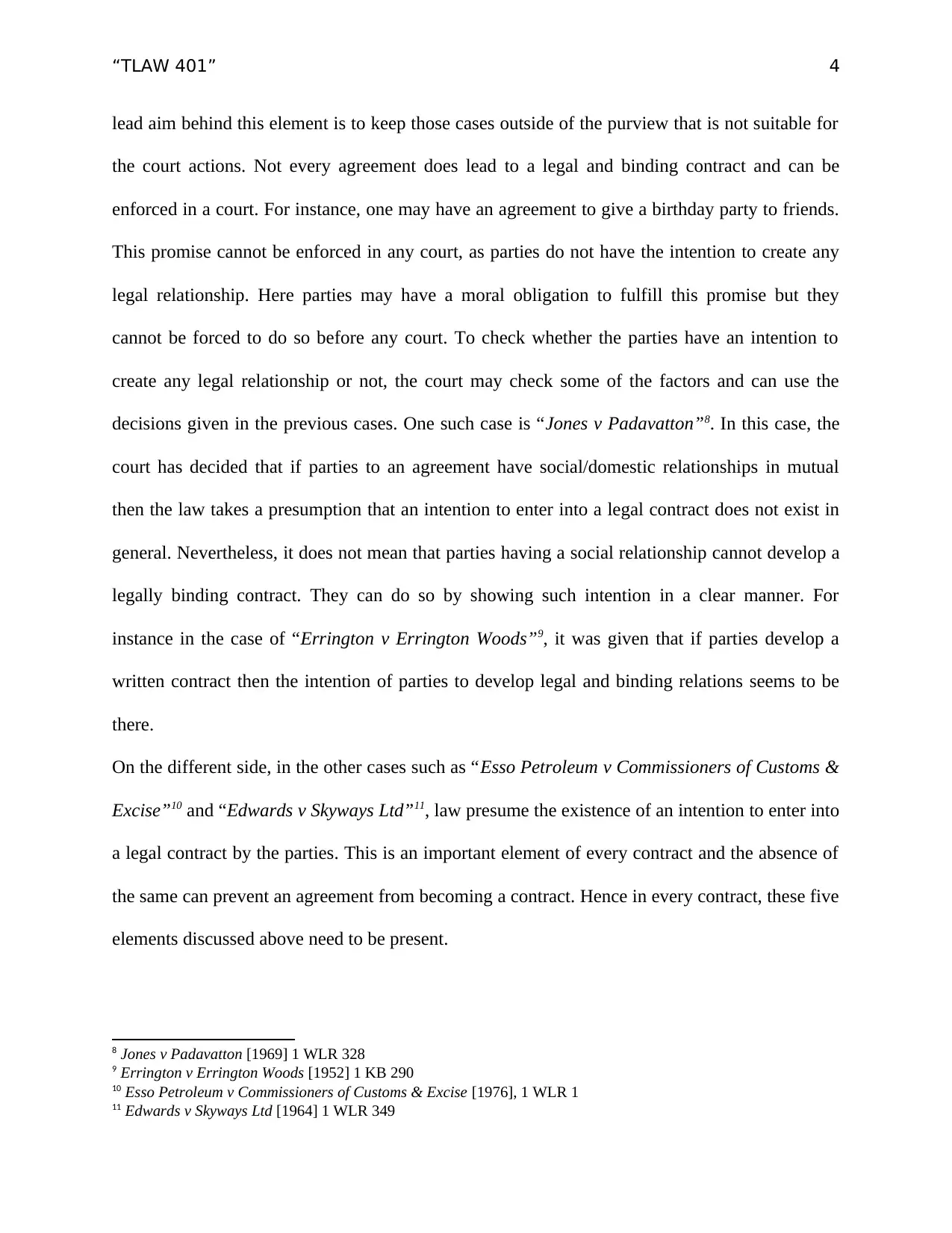
“TLAW 401” 4
lead aim behind this element is to keep those cases outside of the purview that is not suitable for
the court actions. Not every agreement does lead to a legal and binding contract and can be
enforced in a court. For instance, one may have an agreement to give a birthday party to friends.
This promise cannot be enforced in any court, as parties do not have the intention to create any
legal relationship. Here parties may have a moral obligation to fulfill this promise but they
cannot be forced to do so before any court. To check whether the parties have an intention to
create any legal relationship or not, the court may check some of the factors and can use the
decisions given in the previous cases. One such case is “Jones v Padavatton”8. In this case, the
court has decided that if parties to an agreement have social/domestic relationships in mutual
then the law takes a presumption that an intention to enter into a legal contract does not exist in
general. Nevertheless, it does not mean that parties having a social relationship cannot develop a
legally binding contract. They can do so by showing such intention in a clear manner. For
instance in the case of “Errington v Errington Woods”9, it was given that if parties develop a
written contract then the intention of parties to develop legal and binding relations seems to be
there.
On the different side, in the other cases such as “Esso Petroleum v Commissioners of Customs &
Excise”10 and “Edwards v Skyways Ltd”11, law presume the existence of an intention to enter into
a legal contract by the parties. This is an important element of every contract and the absence of
the same can prevent an agreement from becoming a contract. Hence in every contract, these five
elements discussed above need to be present.
8 Jones v Padavatton [1969] 1 WLR 328
9 Errington v Errington Woods [1952] 1 KB 290
10 Esso Petroleum v Commissioners of Customs & Excise [1976], 1 WLR 1
11 Edwards v Skyways Ltd [1964] 1 WLR 349
lead aim behind this element is to keep those cases outside of the purview that is not suitable for
the court actions. Not every agreement does lead to a legal and binding contract and can be
enforced in a court. For instance, one may have an agreement to give a birthday party to friends.
This promise cannot be enforced in any court, as parties do not have the intention to create any
legal relationship. Here parties may have a moral obligation to fulfill this promise but they
cannot be forced to do so before any court. To check whether the parties have an intention to
create any legal relationship or not, the court may check some of the factors and can use the
decisions given in the previous cases. One such case is “Jones v Padavatton”8. In this case, the
court has decided that if parties to an agreement have social/domestic relationships in mutual
then the law takes a presumption that an intention to enter into a legal contract does not exist in
general. Nevertheless, it does not mean that parties having a social relationship cannot develop a
legally binding contract. They can do so by showing such intention in a clear manner. For
instance in the case of “Errington v Errington Woods”9, it was given that if parties develop a
written contract then the intention of parties to develop legal and binding relations seems to be
there.
On the different side, in the other cases such as “Esso Petroleum v Commissioners of Customs &
Excise”10 and “Edwards v Skyways Ltd”11, law presume the existence of an intention to enter into
a legal contract by the parties. This is an important element of every contract and the absence of
the same can prevent an agreement from becoming a contract. Hence in every contract, these five
elements discussed above need to be present.
8 Jones v Padavatton [1969] 1 WLR 328
9 Errington v Errington Woods [1952] 1 KB 290
10 Esso Petroleum v Commissioners of Customs & Excise [1976], 1 WLR 1
11 Edwards v Skyways Ltd [1964] 1 WLR 349
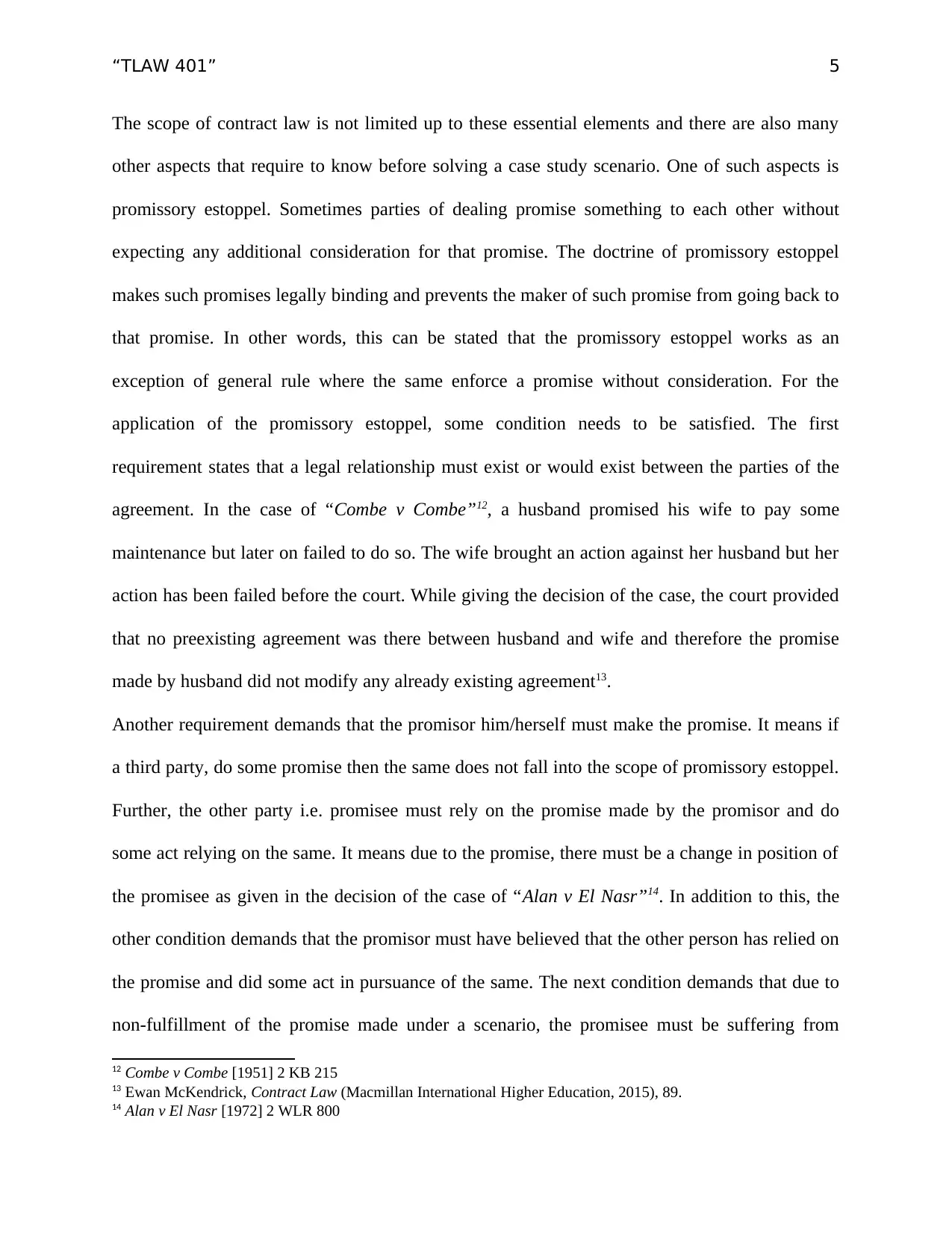
“TLAW 401” 5
The scope of contract law is not limited up to these essential elements and there are also many
other aspects that require to know before solving a case study scenario. One of such aspects is
promissory estoppel. Sometimes parties of dealing promise something to each other without
expecting any additional consideration for that promise. The doctrine of promissory estoppel
makes such promises legally binding and prevents the maker of such promise from going back to
that promise. In other words, this can be stated that the promissory estoppel works as an
exception of general rule where the same enforce a promise without consideration. For the
application of the promissory estoppel, some condition needs to be satisfied. The first
requirement states that a legal relationship must exist or would exist between the parties of the
agreement. In the case of “Combe v Combe”12, a husband promised his wife to pay some
maintenance but later on failed to do so. The wife brought an action against her husband but her
action has been failed before the court. While giving the decision of the case, the court provided
that no preexisting agreement was there between husband and wife and therefore the promise
made by husband did not modify any already existing agreement13.
Another requirement demands that the promisor him/herself must make the promise. It means if
a third party, do some promise then the same does not fall into the scope of promissory estoppel.
Further, the other party i.e. promisee must rely on the promise made by the promisor and do
some act relying on the same. It means due to the promise, there must be a change in position of
the promisee as given in the decision of the case of “Alan v El Nasr”14. In addition to this, the
other condition demands that the promisor must have believed that the other person has relied on
the promise and did some act in pursuance of the same. The next condition demands that due to
non-fulfillment of the promise made under a scenario, the promisee must be suffering from
12 Combe v Combe [1951] 2 KB 215
13 Ewan McKendrick, Contract Law (Macmillan International Higher Education, 2015), 89.
14 Alan v El Nasr [1972] 2 WLR 800
The scope of contract law is not limited up to these essential elements and there are also many
other aspects that require to know before solving a case study scenario. One of such aspects is
promissory estoppel. Sometimes parties of dealing promise something to each other without
expecting any additional consideration for that promise. The doctrine of promissory estoppel
makes such promises legally binding and prevents the maker of such promise from going back to
that promise. In other words, this can be stated that the promissory estoppel works as an
exception of general rule where the same enforce a promise without consideration. For the
application of the promissory estoppel, some condition needs to be satisfied. The first
requirement states that a legal relationship must exist or would exist between the parties of the
agreement. In the case of “Combe v Combe”12, a husband promised his wife to pay some
maintenance but later on failed to do so. The wife brought an action against her husband but her
action has been failed before the court. While giving the decision of the case, the court provided
that no preexisting agreement was there between husband and wife and therefore the promise
made by husband did not modify any already existing agreement13.
Another requirement demands that the promisor him/herself must make the promise. It means if
a third party, do some promise then the same does not fall into the scope of promissory estoppel.
Further, the other party i.e. promisee must rely on the promise made by the promisor and do
some act relying on the same. It means due to the promise, there must be a change in position of
the promisee as given in the decision of the case of “Alan v El Nasr”14. In addition to this, the
other condition demands that the promisor must have believed that the other person has relied on
the promise and did some act in pursuance of the same. The next condition demands that due to
non-fulfillment of the promise made under a scenario, the promisee must be suffering from
12 Combe v Combe [1951] 2 KB 215
13 Ewan McKendrick, Contract Law (Macmillan International Higher Education, 2015), 89.
14 Alan v El Nasr [1972] 2 WLR 800
⊘ This is a preview!⊘
Do you want full access?
Subscribe today to unlock all pages.

Trusted by 1+ million students worldwide
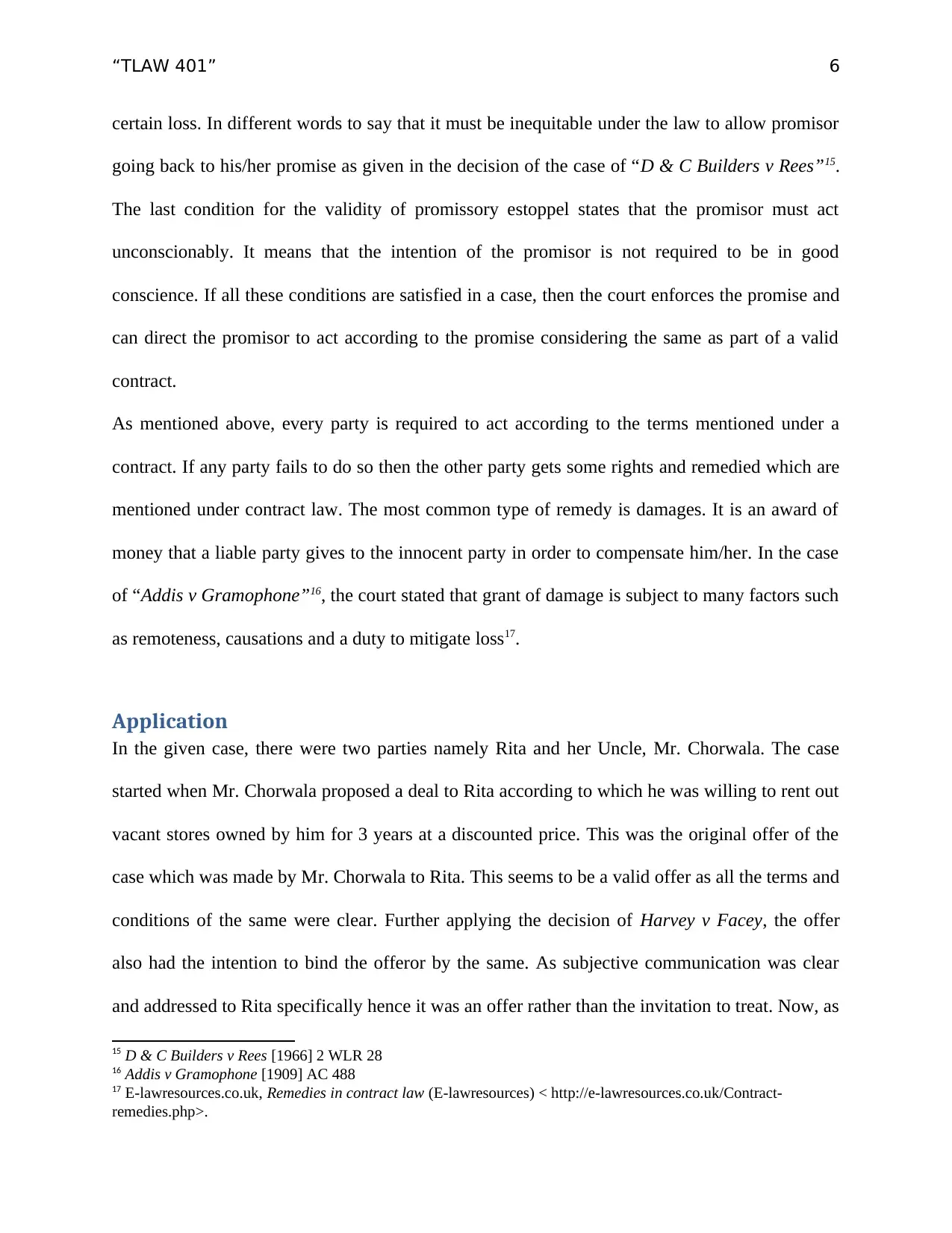
“TLAW 401” 6
certain loss. In different words to say that it must be inequitable under the law to allow promisor
going back to his/her promise as given in the decision of the case of “D & C Builders v Rees”15.
The last condition for the validity of promissory estoppel states that the promisor must act
unconscionably. It means that the intention of the promisor is not required to be in good
conscience. If all these conditions are satisfied in a case, then the court enforces the promise and
can direct the promisor to act according to the promise considering the same as part of a valid
contract.
As mentioned above, every party is required to act according to the terms mentioned under a
contract. If any party fails to do so then the other party gets some rights and remedied which are
mentioned under contract law. The most common type of remedy is damages. It is an award of
money that a liable party gives to the innocent party in order to compensate him/her. In the case
of “Addis v Gramophone”16, the court stated that grant of damage is subject to many factors such
as remoteness, causations and a duty to mitigate loss17.
Application
In the given case, there were two parties namely Rita and her Uncle, Mr. Chorwala. The case
started when Mr. Chorwala proposed a deal to Rita according to which he was willing to rent out
vacant stores owned by him for 3 years at a discounted price. This was the original offer of the
case which was made by Mr. Chorwala to Rita. This seems to be a valid offer as all the terms and
conditions of the same were clear. Further applying the decision of Harvey v Facey, the offer
also had the intention to bind the offeror by the same. As subjective communication was clear
and addressed to Rita specifically hence it was an offer rather than the invitation to treat. Now, as
15 D & C Builders v Rees [1966] 2 WLR 28
16 Addis v Gramophone [1909] AC 488
17 E-lawresources.co.uk, Remedies in contract law (E-lawresources) < http://e-lawresources.co.uk/Contract-
remedies.php>.
certain loss. In different words to say that it must be inequitable under the law to allow promisor
going back to his/her promise as given in the decision of the case of “D & C Builders v Rees”15.
The last condition for the validity of promissory estoppel states that the promisor must act
unconscionably. It means that the intention of the promisor is not required to be in good
conscience. If all these conditions are satisfied in a case, then the court enforces the promise and
can direct the promisor to act according to the promise considering the same as part of a valid
contract.
As mentioned above, every party is required to act according to the terms mentioned under a
contract. If any party fails to do so then the other party gets some rights and remedied which are
mentioned under contract law. The most common type of remedy is damages. It is an award of
money that a liable party gives to the innocent party in order to compensate him/her. In the case
of “Addis v Gramophone”16, the court stated that grant of damage is subject to many factors such
as remoteness, causations and a duty to mitigate loss17.
Application
In the given case, there were two parties namely Rita and her Uncle, Mr. Chorwala. The case
started when Mr. Chorwala proposed a deal to Rita according to which he was willing to rent out
vacant stores owned by him for 3 years at a discounted price. This was the original offer of the
case which was made by Mr. Chorwala to Rita. This seems to be a valid offer as all the terms and
conditions of the same were clear. Further applying the decision of Harvey v Facey, the offer
also had the intention to bind the offeror by the same. As subjective communication was clear
and addressed to Rita specifically hence it was an offer rather than the invitation to treat. Now, as
15 D & C Builders v Rees [1966] 2 WLR 28
16 Addis v Gramophone [1909] AC 488
17 E-lawresources.co.uk, Remedies in contract law (E-lawresources) < http://e-lawresources.co.uk/Contract-
remedies.php>.
Paraphrase This Document
Need a fresh take? Get an instant paraphrase of this document with our AI Paraphraser

“TLAW 401” 7
per the contract law provisions, Rita was required to give her consent over this offer in order to
develop a contract. She accepted the offer without making any change to the terms. This
acceptance seems to be valid as the same was duly communicated to the offeror, Mr. Chorwala.
In addition to this applying “Scammell & Nephew v. Ouston”, it could be checked by the
acceptance that what the parties have agreed to do. Hence, it was a valid consent of this case.
As offer and consent were there hence the existence of the rest of the elements of contract needs
to be check hereby. The third element i.e. consideration also seems to be available there. The
store space was consideration for Rita whereas for his uncle the discounted price, which Rita
expected to pay, was a consideration. Both of these considerations seem to be valid as they have
certain values in the eyes of law. Further as given in the case of Chappell v Nestle, the
discounted price would not be an issue as the consideration was not required to be adequate
where the same was sufficient.
Both the parties of the transactions are likely to be capable to develop a valid contract since
neither Rita nor Mt. Chorwala pursues any incapability. To check the existence of the last
element i.e. intention of the parties to create legal relation, this is to state that parties had social
relationships in mutual. Applying the provisions of Jones v Padavatton, the subjective intention
seems to be missing. In addition to this, no exception to this would be applicable as a written
contract was also not there. However, parties had a discussion about lease deed which shows that
they both wanted to enter into a legal contract. Regardless of the fact that a deed was never been
signed but the same was developed and expected to be executed between the parties, hence to
state that the intention to create a legal relationship existed in the case. As all the essentials of the
contract existed in the dealings of Rita and Mr. Chorwala hence it is concluded that a valid
contract was developed between them.
per the contract law provisions, Rita was required to give her consent over this offer in order to
develop a contract. She accepted the offer without making any change to the terms. This
acceptance seems to be valid as the same was duly communicated to the offeror, Mr. Chorwala.
In addition to this applying “Scammell & Nephew v. Ouston”, it could be checked by the
acceptance that what the parties have agreed to do. Hence, it was a valid consent of this case.
As offer and consent were there hence the existence of the rest of the elements of contract needs
to be check hereby. The third element i.e. consideration also seems to be available there. The
store space was consideration for Rita whereas for his uncle the discounted price, which Rita
expected to pay, was a consideration. Both of these considerations seem to be valid as they have
certain values in the eyes of law. Further as given in the case of Chappell v Nestle, the
discounted price would not be an issue as the consideration was not required to be adequate
where the same was sufficient.
Both the parties of the transactions are likely to be capable to develop a valid contract since
neither Rita nor Mt. Chorwala pursues any incapability. To check the existence of the last
element i.e. intention of the parties to create legal relation, this is to state that parties had social
relationships in mutual. Applying the provisions of Jones v Padavatton, the subjective intention
seems to be missing. In addition to this, no exception to this would be applicable as a written
contract was also not there. However, parties had a discussion about lease deed which shows that
they both wanted to enter into a legal contract. Regardless of the fact that a deed was never been
signed but the same was developed and expected to be executed between the parties, hence to
state that the intention to create a legal relationship existed in the case. As all the essentials of the
contract existed in the dealings of Rita and Mr. Chorwala hence it is concluded that a valid
contract was developed between them.

“TLAW 401” 8
However the store space was not ready to use as it has previously been used as a restaurant and
due to an oven fixed to one of the walls of it, Rita could not use the store for her business
purpose without going ahead with the renovation. Rita asked for lease deed to sign several times
to her uncle but Mr. Chorwala did not provide the same to her. Instead of giving the deed to her,
he has confirmed her that the deal is final and there was no need to be a worry. He handed over
store keys to her and stated that she (Rita) could start the renovation work. It was a promise that
Mr. Chorwala made to Rita. Here to check the application of promissory estoppel, this is to state
that all the required for the same seems to be satisfied here. Firstly, a legal contract already
existed between the parties. Further, the assumption was induced by Mr, Chorwala himself.
Relying on this assumption, Rita pursued the renovation work and spent $40, 000. Now, Mr.
Chorwala wants to go back on his promise stating that no deed has been signed by the parties
hence no contract was there. Considering the provisions of promissory estoppel this is to state
that Rita would suffer if Mr. Chorwala would be allowed to go back on his promise and in the
given case, he is acting unconscionably. Therefore, considering the provisions of promissory
estoppel and contract law, Rita has a right to enforce the contract.
Conclusion
As a valid contract is there and all the requirements of promissory estoppel are satisfied hence
Rita can enforce the contract against her uncle. In addition to this, in case of breach of this
contract, she may ask for remedy in the form of damages.
However the store space was not ready to use as it has previously been used as a restaurant and
due to an oven fixed to one of the walls of it, Rita could not use the store for her business
purpose without going ahead with the renovation. Rita asked for lease deed to sign several times
to her uncle but Mr. Chorwala did not provide the same to her. Instead of giving the deed to her,
he has confirmed her that the deal is final and there was no need to be a worry. He handed over
store keys to her and stated that she (Rita) could start the renovation work. It was a promise that
Mr. Chorwala made to Rita. Here to check the application of promissory estoppel, this is to state
that all the required for the same seems to be satisfied here. Firstly, a legal contract already
existed between the parties. Further, the assumption was induced by Mr, Chorwala himself.
Relying on this assumption, Rita pursued the renovation work and spent $40, 000. Now, Mr.
Chorwala wants to go back on his promise stating that no deed has been signed by the parties
hence no contract was there. Considering the provisions of promissory estoppel this is to state
that Rita would suffer if Mr. Chorwala would be allowed to go back on his promise and in the
given case, he is acting unconscionably. Therefore, considering the provisions of promissory
estoppel and contract law, Rita has a right to enforce the contract.
Conclusion
As a valid contract is there and all the requirements of promissory estoppel are satisfied hence
Rita can enforce the contract against her uncle. In addition to this, in case of breach of this
contract, she may ask for remedy in the form of damages.
⊘ This is a preview!⊘
Do you want full access?
Subscribe today to unlock all pages.

Trusted by 1+ million students worldwide
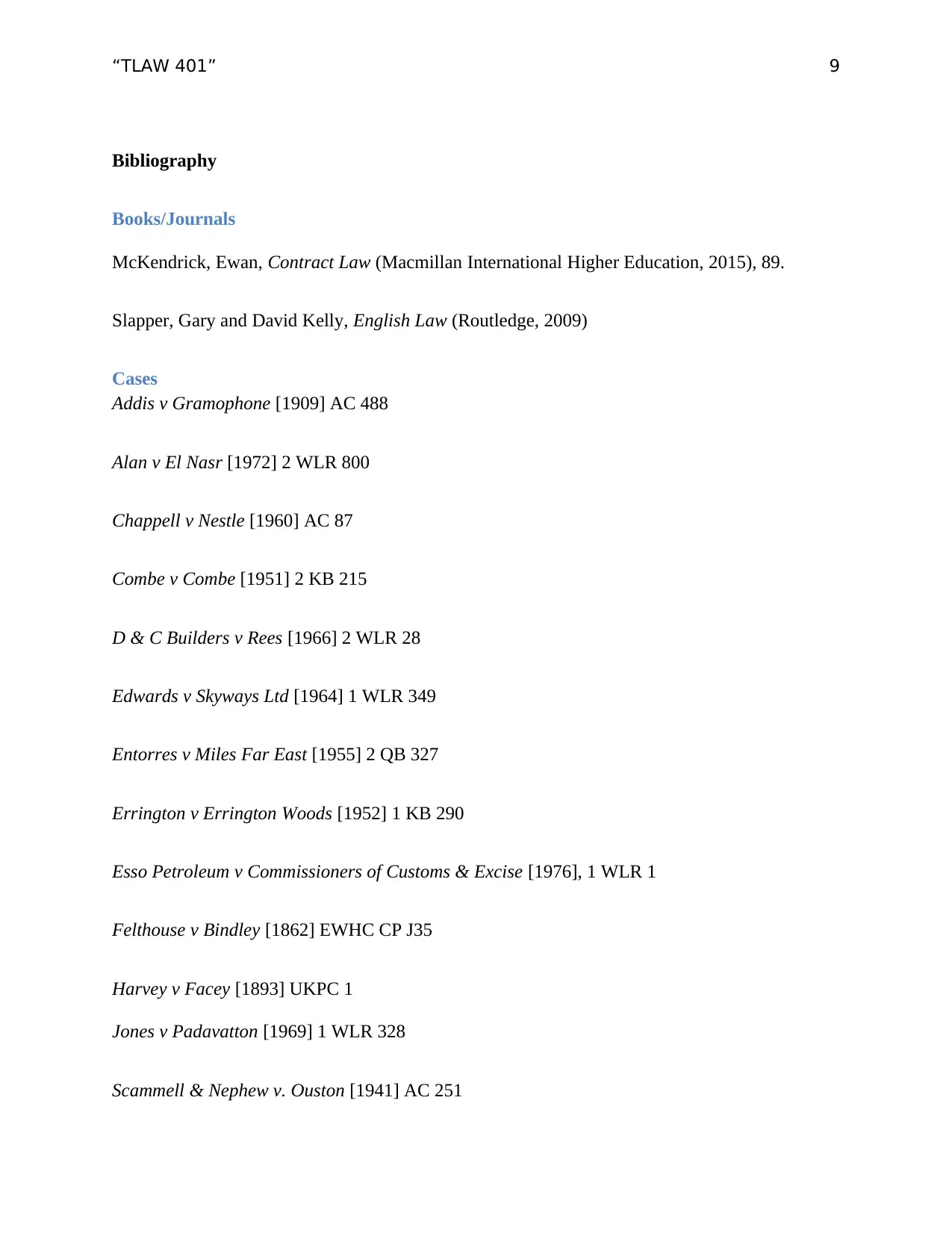
“TLAW 401” 9
Bibliography
Books/Journals
McKendrick, Ewan, Contract Law (Macmillan International Higher Education, 2015), 89.
Slapper, Gary and David Kelly, English Law (Routledge, 2009)
Cases
Addis v Gramophone [1909] AC 488
Alan v El Nasr [1972] 2 WLR 800
Chappell v Nestle [1960] AC 87
Combe v Combe [1951] 2 KB 215
D & C Builders v Rees [1966] 2 WLR 28
Edwards v Skyways Ltd [1964] 1 WLR 349
Entorres v Miles Far East [1955] 2 QB 327
Errington v Errington Woods [1952] 1 KB 290
Esso Petroleum v Commissioners of Customs & Excise [1976], 1 WLR 1
Felthouse v Bindley [1862] EWHC CP J35
Harvey v Facey [1893] UKPC 1
Jones v Padavatton [1969] 1 WLR 328
Scammell & Nephew v. Ouston [1941] AC 251
Bibliography
Books/Journals
McKendrick, Ewan, Contract Law (Macmillan International Higher Education, 2015), 89.
Slapper, Gary and David Kelly, English Law (Routledge, 2009)
Cases
Addis v Gramophone [1909] AC 488
Alan v El Nasr [1972] 2 WLR 800
Chappell v Nestle [1960] AC 87
Combe v Combe [1951] 2 KB 215
D & C Builders v Rees [1966] 2 WLR 28
Edwards v Skyways Ltd [1964] 1 WLR 349
Entorres v Miles Far East [1955] 2 QB 327
Errington v Errington Woods [1952] 1 KB 290
Esso Petroleum v Commissioners of Customs & Excise [1976], 1 WLR 1
Felthouse v Bindley [1862] EWHC CP J35
Harvey v Facey [1893] UKPC 1
Jones v Padavatton [1969] 1 WLR 328
Scammell & Nephew v. Ouston [1941] AC 251
Paraphrase This Document
Need a fresh take? Get an instant paraphrase of this document with our AI Paraphraser

“TLAW 401” 10
Other Resources
E-lawresources.co.uk, Remedies in contract law (E-lawresources) < http://e-
lawresources.co.uk/Contract-remedies.php>.
lawbuddy.com.au, Contracts In Australia (law Buddy)
<https://www.lawbuddy.com.au/contracts-in-australia/>.
Other Resources
E-lawresources.co.uk, Remedies in contract law (E-lawresources) < http://e-
lawresources.co.uk/Contract-remedies.php>.
lawbuddy.com.au, Contracts In Australia (law Buddy)
<https://www.lawbuddy.com.au/contracts-in-australia/>.
1 out of 11
Related Documents
Your All-in-One AI-Powered Toolkit for Academic Success.
+13062052269
info@desklib.com
Available 24*7 on WhatsApp / Email
![[object Object]](/_next/static/media/star-bottom.7253800d.svg)
Unlock your academic potential
Copyright © 2020–2025 A2Z Services. All Rights Reserved. Developed and managed by ZUCOL.




